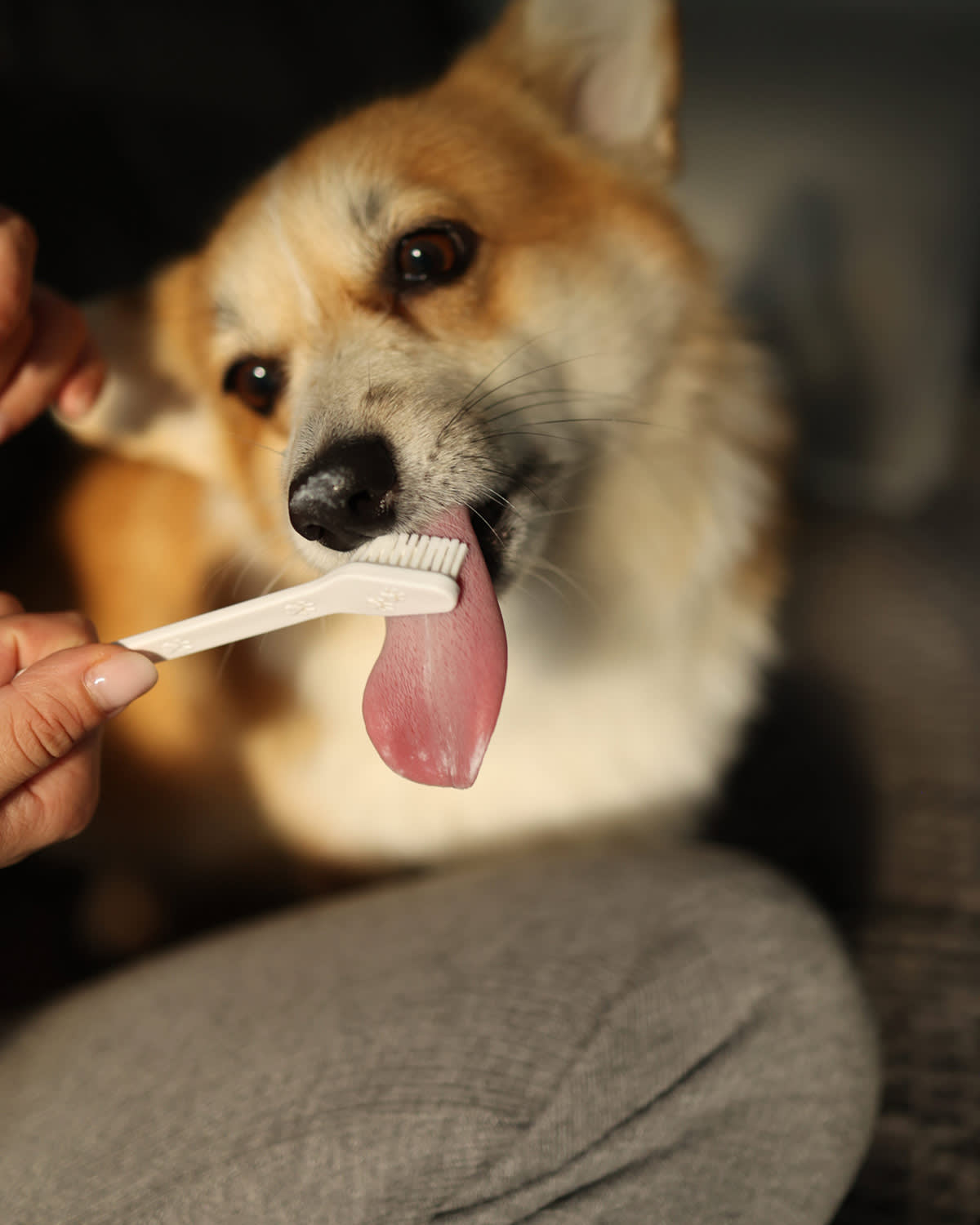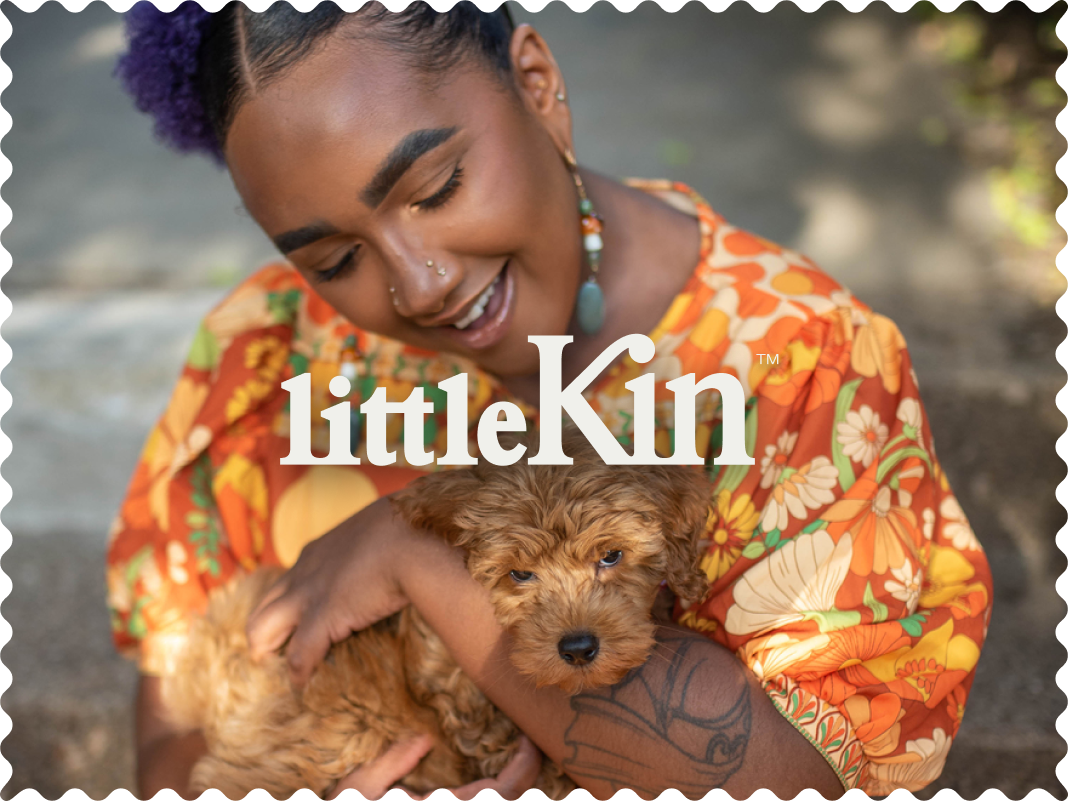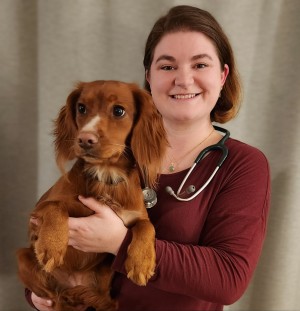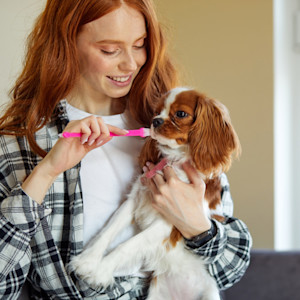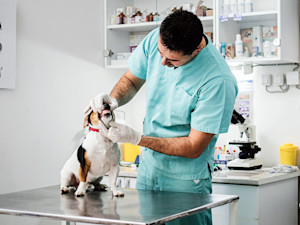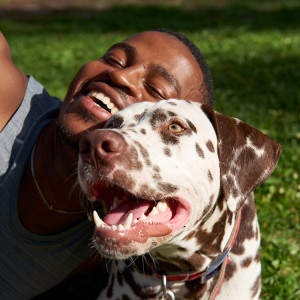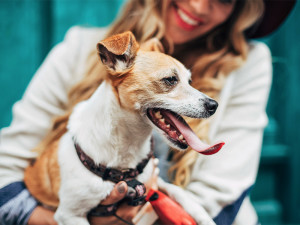10 Unexpected Reasons to Take Your Dog to The Dentist Now
Your dog’s dental health affects their entire well-being
Brushing our teeth is a vital part of our daily routine, twice a day, every day! But when was the last time your dog’s dental hygiene was considered? This area of pet healthcare is often an after-thought or only noticed when a you smell a whiff of that famous doggy bad breath. Read on to see what we can do as pet parents and vets to help our pups keep their pearly whites sparkling.
Why your dog’s dental health matters
Did you know that one in eight dogs suffer from dental diseaseopens in new tab every year, and periodontal disease is the most common disease in dogs over three years oldopens in new tab. This is why dogs need veterinary dental care along with a dental hygiene routine at home. Dental disease is an umbrella term for dental issues such as plaque and tartar build up on the tooth surface, gingivitis where the gum is inflamed and periodontal disease. Periodontal disease is where there is ligament and bone loss from under the gum surface leading to teeth being lost or tooth root abscesses. Not only are these issues painful if not treated, but they can cause further issues impacting your dog’s quality and length of life.
10 reasons to book your dog a dentist appointment
Dental disease can be silent – until it’s serious
A lot of things can be hidden behind a smile, including dental issues. It can unfortunately go unnoticed for a long time, and only spotted when it has become a serious health concern. Check those teeth often and watch for any signs of pain, for example only eating on one side of their mouth.
Bad breath might be a red flag, not a quirk
Bad dog breath has become almost normal, a running joke, but it is no laughing matter. Bad breath, called halitosis, can be a sign of dental issues and should be checked out. It’s a sign bacteria is thriving somewhere, and we need to find it.
Pain isn’t always obvious in dogs
“My dog is fine, he’s still eating …” A common phrase we vets hear, however it can take a lot to put some dogs off their food or to show pain. This is a survival tactic, and a good one, but we need to make sure our pups are really as comfortable as they say they are. Watch their behaviour and facial expressions carefully for any changes.
Tartar build-up doesn’t go away on its own
While plaque, the sticky biofilm of bacteria, can be broken down and improved with dental hygiene measures to some degree, tartar does not go away on its own. This calcified hard calculus buildup needs veterinary dental professional treatment to remove.
Infected teeth can affect organs like the heart and kidneys
Infected teeth involve bacteria and that bacteria can enter the rest of the body through the blood stream and has been linked to systemic diseasesopens in new tab. The bacteria can be transported throughout the body, and can cause serious issues to other organs like the heart opens in new tab and kidneys.
Gum disease is more common than you think
In one reviewopens in new tab, while an average prevalence of 9.3–18.2% dogs in a population were found to have dental and gum issues through visual inspection, a whopping 44–100% prevalence was found after detailed examinations of anaesthetised dogs. This means that what we can see from your pup’s smile is only the tip of the iceberg! Talk to your vet to check if an in-depth dental inspection is needed.
Your dog might already be in discomfort without you knowing
Dogs can be very stoic when uncomfortable, all they want to do is please us so they often pretend all is well. This stems from their survival instinct to not look weak to others or higher predators. Sometimes the discomfort is chronic and so it becomes their new normal and they become accustomed to it. But as we all know, toothache can be very painful.
Regular cleaning can save you money in the long run
Brushing your dog’s teeth can help break down and remove plaque build up, this can delay the development of the hardened tartar. So regular at home dental hygiene can reduce the need for dental procedures in the future, it also provides an excellent opportunity to inspect for any changes.
Anaesthetic-free cleanings aren’t always enough
Anaesthetic-free cleanings only do part of the job, while the teeth surface may look better you can’t see what lurks underneath the gum line. Any scaling or use of dental instruments under the gum line has to be performed at your vets as anaesthesia is needed. It’s used not only because this procedure would be uncomfortable to your pet but if performed while conscious the tissues surrounding the teeth can be damaged if your pet moves which would make things much worse.
Dental health = better quality of life for longer
Apart from reducing the risk of systemic and future dental issues, it is common to see a patient come back in for their check-up after a dental procedure with a new lease of life. It is one of the best things to hear their humans say their older dog is acting like their younger selves again now the unseen chronic tooth pain has been cured.
What a dog dental appointment actually involves
So you’ve booked a dental procedure at your vets, let’s look at what your pup can expect on the day.
Pre-op arrival
Consent forms for the procedure along with information such as when your dog last ate is filled in on arrival.
Anaesthetic check and induction
Your pup will have a personalised anaesthetic plan created for their individual needs after a check over by the veterinary team. They will be anaesthetised and made comfortable for the procedure – your dog’s comfort is carefully monitored throughout their stay typically with the use of multi-parameter monitors alongside nursing care.
Dental inspection
Your vet will inspect each tooth individually (yes all 42 of them!) making a chart of what they find, to create a treatment plan. This is when dental X-rays are also performed if necessary.
Scale and polish
Ultrasonic scaling instruments are then used to clean off the hardened tartar calculus on the tooth surface and under the gum line, and then gone over again with a polishing instrument.
Extractions
If any tooth is too loose or damaged then extractions can be performed while your pup is comfortably asleep.
Post-op recovery
Once the procedure is complete, recovery is generally quick and your pup is usually home the same day. They may be drowsy for a day afterwards and have medications like on-going pain relief or antibiotics depending on the issues found through the inspection.
Cost
The cost of dental procedure varies greatly depending on multiple factors, such as what issues are found during the inspection and length of the procedure. It covers the anaesthesia, scale and polish, procedures such as extractions and the continual nursing care, along with all the medication and equipment use such as the dental X-ray and sterile instruments. Cost can range in the UK from £150 to over £500. Unlike with humans where dental procedures and inspections are recommended yearly, dogs who have good at-home dental healthcare may only need to go through dental procedures once or twice in their lifetime.
How to keep your dog’s teeth healthy between appointments
Brushing your dog’s teeth should be as routine as brushing your own. Try to build it in gradually and playfully, with lots of encouragement to make it normal and stress free. Use a dog specific enzymatic toothpaste and you can find easy-to-use brushes to put on your finger if preferred.
Dental chews don’t replace brushing, but they do have their place for reducing plaque and aiding your dog’s dental health, along with water additives and topical dog dental gels. Another important aspect is diet, as this can have a big impact on dental health in dogs, just the same as with us humans. Talk to your vet about your dog’s individual health and dental needs and what’s best for them.
Ready to book that appointment?
If any of what has been covered here has sounded familiar to you and your pup’s situation, talk to your vet about next steps, this could be a chat about which dental products you need to stock up on, an in-person dental check over or booking in that dental procedure they have been recommending for your pet. Lastly, speak to your vet pronto if any of these potentially serious issues are seen:
growths or dark lumps found in the mouth
bleeding gums or broken teeth
grey or darker coloured individual teeth
pale or bright red gums
unusual drooling or changes in eating behaviours
pawing at their mouth
facial swelling or hard lumps by their cheek
The bottom line: why you should take your dog to the dentist
Your dog’s dental health is often overlooked, despite its impact on their overall well-being. Dental disease is common and can cause serious issues if untreated, including pain, tooth loss and even damage to vital organs. Regular at-home care – like brushing, using dental chews and monitoring for warning signs – combined with professional vet check-ups and cleanings under anaesthetic, can prevent problems and improve your dog’s quality of life.
References
Niemiec, Brook. Veterinary Periodontology. United Kingdom, Wiley, 2013.
O’Neill, D. G., et al. “Epidemiology of Periodontal Disease in Dogs in theUKPrimary‐Care Veterinary Settingopens in new tab.” Journal of Small Animal Practice, vol. 62, no. 12, Wiley, Aug. 2021, pp. 1051–61. Accessed 18 June 2025.
Penlington, L., and Z. Faixová. “Periodontal Disease in Association with Systemic Diseases in the Dogopens in new tab.” Folia Veterinaria, vol. 63, no. 4, Walter de Gruyter GmbH, Dec. 2019, pp. 1–8. Accessed 18 June 2025.
Pereira dos Santos, José Diogo, et al. “Relation between Periodontal Disease and Systemic Diseases in Dogsopens in new tab.” Research in Veterinary Science, vol. 125, Elsevier BV, Aug. 2019, pp. 136–40. Accessed 18 June 2025.
Wallis, C., and L. J. Holcombe. “A Review of the Frequency and Impact of Periodontal Disease in Dogsopens in new tab.” Journal of Small Animal Practice, vol. 61, no. 9, Wiley, Sept. 2020, pp. 529–40. Accessed 18 June 2025.
